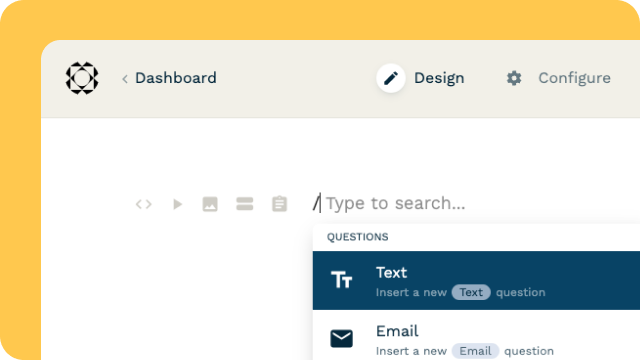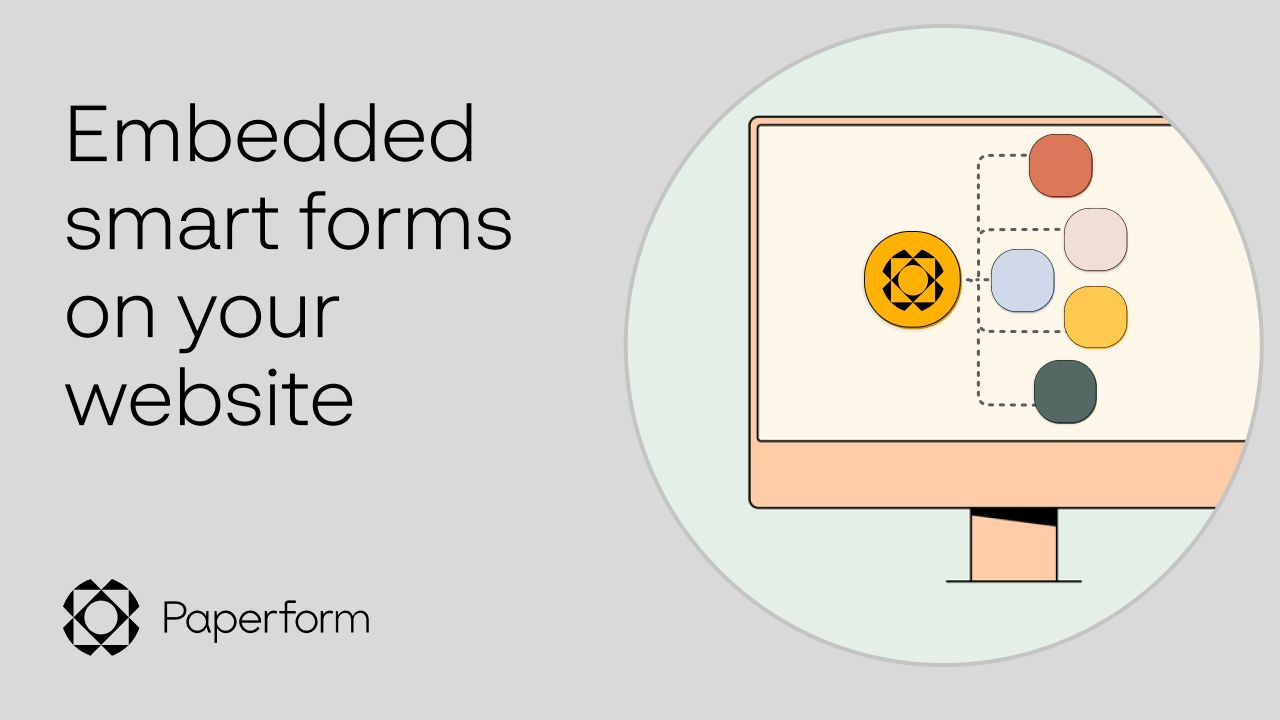
All Solutions

Explore all the solutions you can create with Paperform: surveys, quizzes, tests, payment forms, scheduling forms, and a whole lot more.
See all solutions











Connect with over 2,000 popular apps and software to improve productivity and automate workflows
See all integrationsProducts
Solutions
All Solutions

Explore all the solutions you can create with Paperform: surveys, quizzes, tests, payment forms, scheduling forms, and a whole lot more.
See all solutionsIntegrations

Connect with over 2,000 popular apps and software to improve productivity and automate workflows
See all integrationsResources
How Embedded Smart Forms Can Turn Your Website into a Sales Engine

TD;LR
- Smart forms use advanced conditional logic to display only the most relevant questions for each respondent.
- The forms validate data in real-time to ensure its accuracy and completeness. They also integrate with CRMs, ERPs, and other connected systems, offering a complete view of your customers.
- By adapting to user input, smart forms feel more intuitive and engaging than standard web forms. As a result, they can reduce friction and improve UX.
- The data collected through smart forms allows for more precise audience segmentation, tailored product recommendations, and highly personalized experiences.
- Businesses can use these forms to better understand customer behavior, automate workflows, fine-tune their marketing efforts, and, ultimately, boost sales.
Many websites lose sales long before a customer even considers clicking "Buy." eCommerce businesses, for example, have an average conversion rate of 2-4%. Meaning that just one to four out of every 100 visitors take action, such as placing an order. The reasons vary from slow loading times and weak CTAs to friction during checkout.
Consumers want quick answers, clear navigation, and simple steps otherwise, they’ll head to your competitors. That’s why website design matters and even small details like embedding smart forms and surveys can improve how well your site works.
Building your site with Wix? By integrating smart forms, you can gain deeper insights into your audience and then leverage that data to improve the user experience (UX). The result? Increased order value, greater revenue, and more personalized offers that drive customer loyalty.
Smart forms can be a powerful sales and marketing tool, but only if you use them strategically. Here’s how they work, plus we’ve added a few simple ways you can incorporate them into your site for higher conversions.
What are smart forms?
Regular web forms, such as those used to capture lead data, are static. They show the same fields to every visitor and rely on users to fill them out correctly, regardless of context or intent. If someone skips a field or enters the wrong info, you're left with inaccurate or missing information, which can skew your marketing analytics.
By comparison, smart forms adapt to each user. Their built-in logic allows them to respond in real time, showing only relevant questions and suggesting next steps.
Simply put, they’re dynamic forms that act like a helpful assistant, collecting customer data, triggering follow-ups, and guiding visitors through their journey. For example, their content may change based on factors like:
- Customer location
- Browsing history
- Purchase behavior
- Preferred language
- Device type
- Referral source
Smart forms collect, validate, store, and process data electronically, ensuring accuracy and completeness. They also integrate with your CRM or email marketing platform to automate follow-ups and enrich the data you already have.
How do smart forms work?
Dynamic smart forms use advanced conditional logic to display only the questions that matter to each respondent. This is how they work:
Smart Form Workflow: From Setup to Actionable Insights
| Step | Description |
|---|---|
| #1 — Design & Setup | A user creates the form, adding relevant fields, validation rules, and conditional logic. |
| #2 — User Interaction | Visitors access the form on your website or app, filling in their information. |
| #3 — Instant Validation | Each entry is automatically checked for accuracy and completeness. |
| #4 — Data Capture & Integration | Validated data is sent to CRMs, ERPs, web analytics tools, or other connected systems for storage and processing. |
| #5 — Data Utilization | Businesses use the collected data to generate reports, analyze customer behavior, forecast sales, automate workflows, and more. |
For example, Wix Forms and 123 Form Builder & Payments are good for l small business owners running their websites on Wix. While not enterprise-grade, these tools have smart features that enable users to:
- Show or hide fields based on user input
- Add custom field types
- Manage form submissions in one place
- Provide multiple-choice options
And much more.
Other tools, such as ActiveCampaign and Feathery, offer smart forms tailored to specific goals like email marketing, CRM, or workflow automation. These platforms come with advanced capabilities, but can be more expensive making them better suited for growing or established businesses with complex needs.
Smart forms in action
Before switching to smart forms, determine why you need them in the first place and where they’ll deliver the most value. We’ve put together some use cases to help you do just that.
Let’s say you sell beauty products and want to help shoppers find the right match. Instead of asking visitors to fill out a generic form or survey, use smart forms to tailor your questions based on each customer’s needs.
If someone chooses “dry skin,” the form might ask about sensitivities, preferred product types, or their current skincare routine. If they select “acne-prone skin,” the form can shift to questions about breakout frequency, past treatments, and product allergies.
Smart forms ensure you’re only asking what’s relevant, creating a faster, smoother, and more personalized experience. This means customers are more likely to complete the form, stay longer on your site, and receive recommendations tailored to their needs.
Now imagine you run a boutique fitness studio. A regular lead form might ask for a name, email, and phone number, which can be useful for building your contact list, but not much else. You still don’t know what each person wants from your studio or how much time and money they’re willing to invest. .
A smart form changes that. When a visitor selects “interested in personal training,” the form asks about their fitness goals, preferred schedule, and experience level. But if someone chooses “yoga,” they’ll get a different set of questions.
Based on these more specific insights, you can send personalized offers, schedule sessions that match customer preferences, and follow up in a way that feels much more natural.
The business case for smart forms
Smart forms aren’t just data collection tools but powerful assets that can transform how you make better business decisions and engage with your customers.
Here are some of the top reasons why you should switch to smart forms:
- Greater efficiency: Automating data collection and processing with smart forms reduces manual work, freeing your time for more strategic tasks.
- Improved data accuracy: According to ZoomInfo, inaccurate data causes 40% of business objectives to fail. It also affects the bottom line of 88% of companies, with the average business losing 12% of its revenue because of it.
Smart forms apply conditional logic and validate data in real time, flagging issues as they arise. This ensures the information you collect is accurate and complete, reducing errors and enabling better decisions. - Higher conversion rates: As ZoomInfo notes, companies with high-quality data can generate up to 70% more revenue than the average business. Not only do smart forms improve data quality, but they also streamline the user experience. By reducing friction and saving time, they may help lower bounce rates and customer churn while increasing conversions.
- Enhanced user experience: Most consumers don't have the time or patience to fill out lengthy forms, especially when faced with irrelevant questions. Smart forms are dynamic and highly customizable, creating a more engaging interaction. This level of personalization can improve UX, helping businesses build trust and boost customer satisfaction.
- Seamless integration: Smart forms connect with your existing systems, providing the data you need for a 360-degree view of your customers. This smooth integration makes it easier to define and segment your audience, personalize communications, and track key performance metrics (KPIs) like customer lifetime value, conversion rates, or retention rates.
- Improved regulatory compliance: The data collected via smart forms can help businesses comply with the General Data Protection Regulation (GDPR), the California Consumer Privacy Act (CCPA), and other data protection laws. These forms offer a simple way to collect customer consent through your site and automatically record it in your CRM and other connected systems.
Other potential benefits of smart forms are industry-specific. For example, healthcare businesses use smart forms to collect patient intake information, appointment requests, and consent for medical procedures. The forms can automatically flag missing medical history fields or insurance details, needed for complete records.
High schools and universities may use smart forms to streamline student enrollment, onboarding, tuition assistance, and other processes. Smart forms can also guide students through each admission step while routing their data into institutional databases meaning they might only need to fill out one form.
Ecommerce brands, on the other hand, leverage smart forms to gauge customer satisfaction, collect feedback throughout the sales cycle, and re-engage inactive shoppers. The data gathered can be invaluable for lead nurturing, fueling email campaigns, and other marketing activities.
Get the most out of your smart forms
Embedding smart forms into your website, emails, or ads requires a strategic approach, as you need to make sure they ask the right questions and adapt to your user behavior. It’s essential to set them up in a way that allows you to capture meaningful insights without overwhelming your audience.
A poorly structured form can feel intrusive or confusing, leading to customer churn and missed opportunities. Remember, the goal isn’t just to collect data, but to create a seamless experience that drives action.
With that in mind, here are three best practices to get the most out of your smart forms:
Keep it short and simple
Aim for simplicity, clarity, and relevance when designing your forms. Start with the essentials, then use conditional logic to collect further insights based on each user's input.
For instance, a specialty coffee retailer could ask, "How do you brew your coffee at home?" If a customer selects "French press," the form reveals follow-up questions about roast preference and other aspects, guiding the buyer toward relevant products or brewing tips.
As a general rule, stick to what you really need to know. While it's tempting to ask more questions, doing so can frustrate customers, prompting them to select random answers or type gibberish just to finish the form.
Implement progressive profiling
Ask additional questions over multiple interactions instead of trying to collect everything upfront. This way, you avoid overwhelming visitors with a lengthy form that drives them away. Plus, it’s easier to keep them engaged and build a richer customer profile without coming across as intrusive.
Progressive profiling allows you to keep your forms short and relevant, which can enhance the user experience. According to SAP, reducing the number of fields from 11 to four can boost conversions by as much as 120%.
A good example would be an online skincare brand that asks new visitors only for their names, emails, and one relevant detail, such as their skin type.
On the next interaction, like a product quiz or newsletter signup, the form may include questions about specific concerns, preferences, or past purchases. Over time, the brand builds a detailed customer profile, enabling personalized recommendations and promotions.
Make it interactive
A smart form doesn't have to be a static questionnaire. Consider adding interactive quizzes, slides, clickable icons, or gamification elements like badges, points, and progress bars to drive engagement. These small details make the whole experience more interesting and fun.
Suppose you sell furniture and home decor items. Create visual forms that let visitors pick their preferred style, such as modern or vintage, rather than typing the answer. Not only does this approach improve their experience, but it also reduces errors, visitors can’t mistype or skip a field.
Smart forms, smarter results
Embedded smart forms can be a game-changer for online businesses. While their setup involves a learning curve, you can and should experiment with different approaches.
Add interactive elements to boost engagement, use progressive profiling instead of asking for all information upfront, and keep the number of fields to a minimum. Also, don’t forget accessibility. Descriptive labels, keyboard navigation, high-contrast colors, and generous white space all contribute to a better user experience.
Last but not least, run A/B tests to refine your forms and discover what resonates with your audience. Sometimes, small adjustments like placing a form above the fold or tweaking the CTA copy can boost completion rates and conversions.
Form a better life now.
Get your 7 day unrestricted trialHere is the ultimate list of online form builders, what they do best, their pricing, and examples to...
The ultimate list of Black Friday and Cyber Monday SaaS deals for 2025
Looking for a worthy alternative to Zapier? In this guide, we've reviewed the best automation platfo...